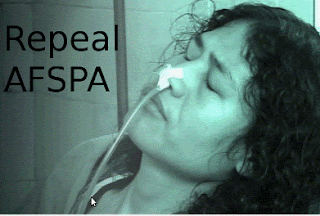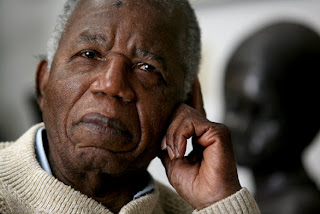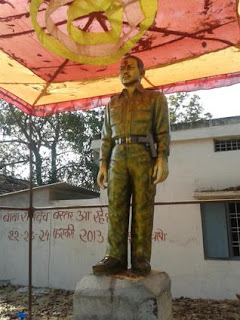Recognise Sharmila's Fasting; Don't ill treat her!!
Hunger striking as a tactic is part of an ancient Indian tradition. The right to protest peacefully is one of the remarkable aspects of living in a democracy. In recent times, in spite of the alarming tendencies at stifling and censuring protest, the culture of protest continues to be vibrant in India. Irom Sharmila has been on hunger strike for over 12 years against the Armed Forces Special Powers Act (AFSPA) which has been an instrument of human rights violation. The purpose of Sharmila’s struggle has been to seek the withdrawal of the AFSPA. Sharmila’s hunger strike is a method of non-violent resistance or an act of political protest to provoke feelings of guilt in the state machinery, with an objective of achieving a specific goal of the repeal of the draconian AFSPA. She didn’t subvert democracy with her hunger strike but indeed she is trying to strengthen it.
Hunger strikes are no doubt a legitimate form of protest in matters of public importance. It is a pressure tactic in an attempt to make the government more accountable. India has a lot more supporting evidences to show that many people have done this in the past like Bhagat Singh’s fast to treat all prisoners equally, VP Singh’s hunger strike against the Bombay Riots in 1993, Medha Patkar’s hunger strike in protest of the Narmada Dam in 2006, etc. It is also true that fasts can be sometimes coercive like Gandhi’s fasting against separate electorates for the untouchables. Even though the way Anna Hazare used fasting methods undemocratically, the state and the media endorsed the drive as passive resistance and yielded to the demands of the campaign. Unfortunately, Sharmila’s indefinite fast for over a decade continues to be ignored by the civil society, the political leadership and the mainstream media.
When Anna Hazare’s hunger strike garnered considerable government attention, why civil rights activist Irom Sharmila’s hunger strike was rebuffed with the slapping of IPC 309? How terribly has the state dealt with Irom Sharmila’s protests? She has frequently been arrested, charged with an attempt to commit suicide, for her sustained fasting. Sharmila is under arrest for over a decade, and is being force-fed, a practice which the World Medical Association deems as a form of inhuman torture and degrading treatment. It has been through her concerted efforts that criticism of AFSPA has become an integral part of civil society discourse. It was totally unconstitutional for the Indian government to place Irom Sharmila under arrest, and it was further immoral of them to accuse her of black-mailing the government. A hunger strike is a perfectly legitimate pressure tactic that has been employed throughout history by many citizens and political leaders, to demand their rights in a democracy. It is a constitutionally valid, non-violent form of protest, which works only when the demand of the person fasting represents popular opinion. Fasting should be allowed as part of any functioning democracy, which allows citizens the right to protest and express their views in any non-violent manner. Hunger-strikes or fasts have long been an essential part of the Indian form of resistance. In a democracy, hunger-strike cannot be tantamount to extra-constitutional blackmail.
For your further reading, The Hindu Report dated 30-03-2013
Starving to live, not die
When the Supreme Court has recognised the right to go on hunger strike, why is Irom Sharmila’s protest against impunity of the armed forces a criminal act?
Over the past 12 years, Irom Sharmila Chanu has carried on an inconceivable hunger strike, which has seen her body wither and her skin turn pale. During this period, she has emerged as the face of the civilian resistance to the immunity, and impunity, granted by the Armed Forces (Special Powers) Act to the army in Manipur. The Indian state has done its part to disfigure that face, by exhibiting either an inability or unwillingness to meet Sharmila’s demands. Today, it is impossible to think of Sharmila without recalling images of the feeding tube that has been forcibly thrust down her nose to keep her alive. However, the repeal of AFSPA and justice for the 10 civilians who were shot dead in November 2002 by the Assam Rifles in supposed retaliation to an attack by insurgents in Malom, Manipur — which triggered Sharmila’s protest — still remain elusive. Instead, Sharmila’s dissent expressed via her fast unto death has repeatedly been viewed as criminal.
Sharmila has put the Indian state in a peculiar position, by reconfiguring the dynamics of power through a public sacrifice of her body. Should the state, as it has done so far, view her indefinite fast through the lens of criminality and consider it “an attempt to commit suicide,” when Sharmila has unequivocally asserted her love of living? Or is it incongruous to do so, especially when the Supreme Court, in its recent and much-hailed intervention in the Ram Lila Maidan protests against corruption, has recognised that “hunger strike is a form of protest which has been accepted, both historically and legally in our constitutional jurisprudence”? In fact, Sharmila’s hunger strike is an area of stark legal vacuum. When there is a conflict between her freedom of expression and the Indian state’s interest, and perhaps duty, in keeping her alive, can a balance between these conflicting ends be struck without criminalising Sharmila’s actions?
Examples of hunger strikes used as an expression of dissent are copious; the suffragettes used them in their campaign seeking the vote for women in England during the early 20th century. Hunger strikes around the world have typically, though not exclusively, been waged by prisoners. Such was the case when some imprisoned Irish Republicans famously went on a hunger strike in 1981 to protest British rule of Ireland, leading to the death of Bobby Sands and nine others. Prisoners tend to use hunger strikes as a mode of protest, either to advocate a cause disagreeable to the state or to express their dissent against what they believe to be a wrongful conviction. In the former category fall cases like that of Marion Wallace Dunlop, a pioneering suffragette who was sent to prison for printing an extract from the Bill of Rights on the wall of St. Stephen’s Hall in the House of Commons. In prison, Dunlop commenced a hunger strike to continue her protest seeking the right of women to vote. In the latter category fall prisoners like William Coleman, who has been on a hunger strike lasting almost five years in a jail in Connecticut, U.S., to protest what he believes to be his wrongful conviction. Since the global trend has been for persons already imprisoned to resort to a hunger strike, this mode of protest has usually been viewed abroad as a prisoners’ rights issue. The state’s response of force-feeding prisoners has been considered by some as being tantamount to torture and an unacceptable intrusion in the autonomy of the prisoner, akin to rape.
However, India’s own experience with hunger strikes, which has been very well documented, has shown that viewing the issue through a prisoners’ rights framework is ill-advised. Our freedom fighters, Mahatma Gandhi in particular, developed and perfected this non-violent form of protest as a facet of satyagraha, and although several hunger strikes were carried out by freedom fighters during periods of incarceration, the resort to this mode of protest has never been an exclusive domain of the imprisoned. For instance, Potti Sreeramulu, a freedom fighter and Gandhian, fasted to his death, in seeking the creation of a separate State of Andhra Pradesh in independent India. The Narmada Bachao Andolan movement witnessed hunger strikes in 2002 to protest the construction of dams over the Maan River in Dhar, Madhya Pradesh.
More recently, Anna Hazare and his associates carried on hunger strikes against corruption. All of these protests were, and continue to be, carried on for the large part, outside the walls of prison. For this reason, a prisoners’ rights framework may, by itself, be insufficient to view the legality of hunger strikes in India.
Attempted suicide?
An alternative way to analyse hunger strikes, especially fasts unto death, is through the framework of a constitutional right to die. In India, not a little morbidly, this argument seems to have reached a “dead end.” Although the Supreme Court in P. Rathinam v. Union of India (1994) initially asserted that the Indian constitutional guarantee of a fundamental right to life carries with it a fundamental right to die, subsequent decisions in Gian Kaur v. State of Punjab (1996) and Aruna Shanbaug v. Union of India (2011) overruled that view, and it is now conclusively established that Indian citizens do not have a fundamental right to die. In Gian Kaur, the Supreme Court upheld the validity of Section 309 of the Indian Penal Code, which criminalises the “attempt to commit suicide” (i.e. the provision under which Sharmila has been charged, and previously convicted). In Shanbaug, the Supreme Court allowed only for a highly circumscribed right to approach courts to seek withdrawal of life support systems for patients in a permanent vegetative state. Thus, it appears futile to argue that Indian citizens have a right to fast unto death when, according to the apex court, they have no right to die. However, this does not automatically mean that the undertaking of fasts unto death is criminal or that one does not have a fundamental right to hunger strike of a definite period where there is no danger of death being caused. One may not have the right to do something, but to do it nonetheless needn’t be criminal.
In independent India, the resort to hunger strikes has usually, though with some exceptions (such as the hunger strike by prisoners within a jail), not been viewed through the lens of criminality. For instance, Potti Sreeramulu was never considered criminal or suicidal by the Indian state for his fatal hunger strike. Anna Hazare likewise has undertaken several indefinite hunger strikes for various causes, but has never been perceived as a criminal on this account. The most prominent example of the Indian state criminalising a fast unto death per se is that of Sharmila’s. If we really believe rape is as vile as we have recently claimed it to be, then would it be just to treat Sharmila’s strike against AFSPA, a law that shields rapists from prosecution, differently from Hazare’s strike against corruption? More importantly, would it be just for a society’s laws to selectively criminalise hunger strikes depending upon the objectives such strikes seek to achieve?
Freedom to express
The questions of whether to treat Sharmila as criminal and whether the state should be allowed to force-feed her are distinct. As misguided as Sharmila’s prosecution may be, the question regarding the legality of nasally force-feeding her to keep her alive still remains open. The Supreme Court has, on the one hand, held that the threat of going on a hunger strike extended by Baba Ramdev at Ram Lila Maidan, cannot be termed illegal. Presumably, this right that the court spoke of flows from a citizen’s right to freedom of expression. That right is subject to “reasonable restrictions” in the interest of the sovereignty and integrity of India, public order, decency, morality, or in relation to contempt of court, defamation or incitement to an offence. If Sharmila’s fast unto death is essentially an exercise of her fundamental right to freedom of expression, the state, in force-feeding her, may presumably be acting in furtherance of its right to impose reasonable restrictions as permitted by our Constitution. However, force-feeding, even if conducted in a humane and largely non-intrusive manner, has been widely considered to be tantamount to torture. Even though the state might merely be imposing restrictions that are reasonable within the meaning of Article 19 of the Constitution, the measure might nonetheless be a violation of Sharmila’s right to life and personal liberty under Article 21.
In our opinion, fasts unto death occupy an area of legal vacuum that offer no easy solutions. Should the state allow Sharmila to die and, in the process, abdicate its duty to protect life? Or must it resort to force-feeding her, even though such actions hit at the core of her bodily integrity? While neither offers a perfectly tailored legal solution, what is certain is that a balance ought to be struck between these starkly conflicting ends without criminalising Sharmila’s actions. For, to do so would be tantamount to stigmatising an exercise by a citizen of her right to freedom of expression in advocating a particular cause when other citizens have used the freedom in exactly the same manner without suffering prosecution, simply because they advocated causes of a different, and less complex, nature.




